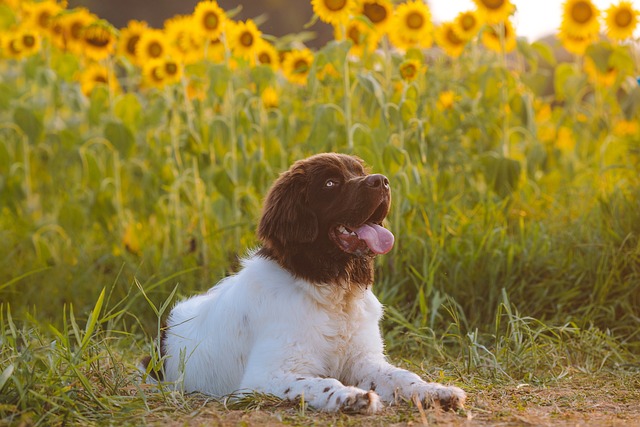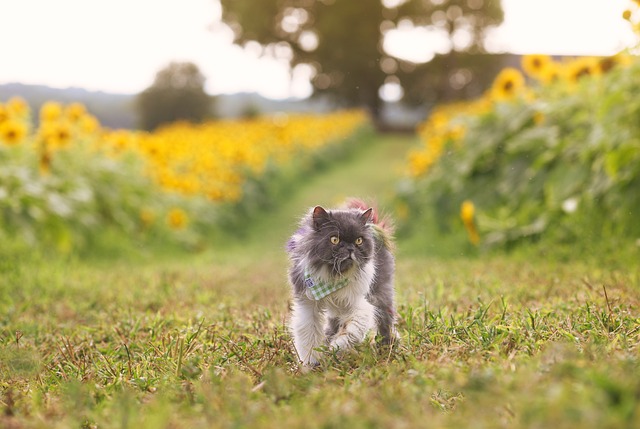Sunflowers Do Not Come Back Year After Year
According to the ASPCA, sunflowers are not toxic to dogs, cats or other pets or wildlife, in fact it is safe for cats and dogs. So you know, we check the flowers we feature on our site with the ASPCA and do extensive internet research for both the common and scientific name just to be super pet safe. If we cannot find direct reference, we check up to genus and so on until we can confirm whether a plant is toxic or non toxic to both cats and dogs. If we are not sure, or get contradictory information, we do not include it. Many of the plants featured we have grown successfully in our own pet safe garden in Northern California. You can see many of garden stars in photos from Lovie’s Pet Safe Garden.
Physical Attributes
- Height: 1-4.5 meters (3-15 feet) tall
- Stem: Thick, erect, rough, and hairy
- Leaves: Broad, coarsely toothed, rough, 7.5-30 cm long
- Flower head: 7.5-30 cm in diameter
- Ray flowers: Yellow (sometimes red or orange in cultivars)
- Disk flowers: Brown, yellow, or purple
- Roots: Deep taproot with abundant secondary roots
- Seeds: Angular achenes, 8-15 mm long, ovoid and flattened

Sunflowers Grow Better in Sun than Shade
General Care Tips
- Sunlight: Full sun (6-8 hours daily)
- Soil: Well-drained, fertile, moist soil
- Water: Regular watering, especially during growth and flowering
- Spacing: 45-60 cm apart for most varieties
- Fertilizer: Moderate feeding; avoid excess nitrogen
- Support: May need staking for tall varieties
- Pests: Watch for aphids, cutworms, and birds
- Harvesting: Cut flower heads when seeds are mature and backs turn brown
Here Are 5 Plus Facts About Sunflowers
Fun Facts
- Exhibits heliotropism: young plants track the sun’s movement
- The flower head is actually composed of hundreds of tiny individual florets
- Sunflowers can be used for phytoremediation to extract toxins from soil
- The tallest sunflower on record reached 9.17 meters (30 ft 1 in)
- Sunflowers are native to the Americas and were cultivated by indigenous peoples
- The Fibonacci sequence can be observed in the arrangement of seeds
- Sunflowers can be used to produce biodiesel fuel
- Van Gogh’s famous sunflower paintings helped popularize the flower in art

| Consideration | Answer |
|---|---|
| Container Friendly | Yes, for dwarf varieties |
| Indoor/Outdoor | Primarily outdoor |
| Sun/Shade | Full sun (6-8 hours daily) |
| Perennial/Annual | Annual |
| Flowering | Mid to late summer |
| Drought Tolerant | Moderately, once established |
| Pollinator Magnet | Yes, attracts bees, butterflies, and birds |
| Beginner Friendly | Yes, easy to grow |
| Good Ground Cover | No |
| Good Privacy Screen | Yes, for tall or giant varieties |
| Invasive/Spreader | Can self-seed, but not typically invasive |
| Hearty/Delicate | Generally hearty |
| Rodent Repellant | No, seeds may attract rodents and squirrels like the flowers |
| Deer Resistant | No, deer often eat sunflowers |
| Native To | North and South America |
| Ideal States/Regions | Adaptable to most regions, best in USDA zones 4-9 |
Citations:
[1] https://www.botanical-online.com/en/botany/sunflower-characteristics
[2] https://verbeekenbol.com/en/news/helianthus-annuus/
[3] https://www.britannica.com/plant/sunflower-plant
[4] https://nuseed.com/eu/biology-of-sunflowers-uncovered/
[5] https://www.sare.org/publications/manage-weeds-on-your-farm/common-sunflower/
[6] https://nuseed.com/eu/biology-of-sunflowers-uncovered/
[7] https://www.botanical-online.com/en/botany/sunflower-characteristics
[8] https://www.britannica.com/plant/sunflower-plant
[9] https://en.wikipedia.org/wiki/Common_sunflower
[10] https://www.fs.usda.gov/wildflowers/plant-of-the-week/helianthus_annuus.shtml





